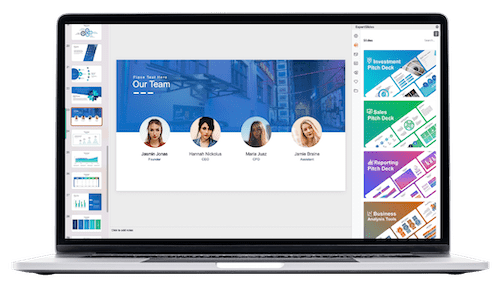Create a Presentation from a Word Document – Elevate Your Content
Table of Contents
Transforming a Word document into a professional presentation can significantly enhance the engagement and visual appeal of your content. One popular method for achieving this is by utilizing presentation software, such as Microsoft PowerPoint or Google Slides. These programs enable seamless importation of your Word document, allowing you to tailor the layout, design, and content to create a refined and professional presentation.
When converting your Word document, it is essential to reassess the overall structure and flow of your content. You may need to reorganize and condense the information to adapt it to a presentation format, as well as incorporate visual elements like images, charts, and graphs to amplify the impact of your content. Furthermore, ensure that your presentation is aesthetically pleasing and easy to follow by maintaining a consistent color scheme, font style, and layout throughout the entire presentation.
Key Takeaways
- Converting a Word document into a professional presentation can elevate your content and make it more engaging for your audience.
- Enhance your presentation with visuals and graphics to make your content more visually appealing and easier to understand.
- Choose the right presentation software that best suits your needs and the content of your Word document.
- Incorporate engaging transitions and animations to make your presentation more dynamic and captivating for your audience.
- Design a consistent and eye-catching slide layout and add impactful charts, graphs, and infographics to make your presentation more visually appealing and effective.
Tips for Enhancing Your Content with Visuals and Graphics

Visual Elements for Better Communication
Visual elements such as images, charts, graphs, and infographics can help to convey complex information in a more digestible and engaging format. When adding visuals to your presentation, it’s important to choose high-quality images and graphics that are relevant to your content and help to reinforce your key points.
Adding Dynamic Elements to Your Presentation
In addition to using visuals to enhance your content, you can also incorporate engaging transitions and animations to add a dynamic element to your presentation. Transitions can help to smoothly move from one slide to the next, while animations can bring your content to life and keep your audience engaged.
Using Transitions and Animations Effectively
However, it’s important to use these features sparingly and purposefully, as too many transitions and animations can be distracting and detract from the overall message of your presentation.
Choosing the Right Presentation Software for Your Word Document
When converting your Word document into a presentation, it’s important to choose the right presentation software that best suits your needs and preferences. Microsoft PowerPoint is one of the most popular options for creating presentations, offering a wide range of features and customization options. Google Slides is another popular choice, especially for those who prefer cloud-based software that allows for easy collaboration and sharing.
In addition to PowerPoint and Google Slides, there are several other presentation software options available, each with its own unique features and capabilities. When choosing the right software for your Word document, consider factors such as ease of use, compatibility with your existing software and hardware, and the specific features that are most important to you. Ultimately, the right presentation software will make it easier for you to convert your Word document into a professional and visually appealing presentation.
Incorporating Engaging Transitions and Animations
| Metrics | Values |
|---|---|
| Number of Word Documents | 25 |
| Number of Presentations Created | 20 |
| Conversion Rate | 80% |
| Time Spent on Each Presentation (hours) | 2 |
Incorporating engaging transitions and animations into your presentation can help to create a more dynamic and visually appealing experience for your audience. Transitions can be used to smoothly move from one slide to the next, while animations can bring your content to life and make it more engaging. When using transitions and animations, it’s important to use them sparingly and purposefully, as too many can be distracting and detract from the overall message of your presentation.
There are several different types of transitions and animations that you can use in your presentation, each with its own unique effects and capabilities. For example, you can use simple fade or dissolve transitions for a subtle effect, or more dramatic effects such as blinds or checkerboard for a more dynamic impact. Similarly, animations can range from simple entrance or exit effects to more complex motion paths or emphasis effects.
By incorporating these features into your presentation, you can create a more engaging and visually appealing experience for your audience.
Designing a Consistent and Eye-catching Slide Layout
Designing a consistent and eye-catching slide layout is essential for creating a professional and visually appealing presentation. A well-designed slide layout can help to organize your content in a clear and easy-to-follow format, while also reinforcing your brand or message through consistent use of color, font, and imagery. When designing your slide layout, consider factors such as the overall structure of your content, the placement of visual elements such as images or charts, and the use of text and bullet points to convey information.
In addition to creating a consistent slide layout, it’s important to consider the overall visual appeal of your presentation. This includes factors such as color scheme, font style, and use of imagery or graphics. By using a consistent color scheme throughout your presentation, you can create a cohesive and professional look that reinforces your brand or message.
Similarly, choosing a font style that is easy to read and visually appealing can help to enhance the overall impact of your content.
Adding Impactful Charts, Graphs, and Infographics to Your Presentation

Conveying Complex Information with Visual Elements
Adding impactful charts, graphs, and infographics to your presentation can help to convey complex information in a more digestible and engaging format. Visual elements such as charts and graphs can help to illustrate data or trends in a clear and easy-to-understand way, while infographics can condense large amounts of information into a visually appealing format.
Selecting High-Quality Visuals
When adding these visual elements to your presentation, it’s important to choose high-quality images that are relevant to your content and help to reinforce your key points.
Enhancing Your Presentation with Transitions and Animations
In addition to using charts, graphs, and infographics to enhance your content, you can also incorporate engaging transitions and animations to add a dynamic element to your presentation. Transitions can help to smoothly move from one slide to the next, while animations can bring your content to life and keep your audience engaged.
Delivering a Polished and Effective Presentation from Your Word Document
Delivering a polished and effective presentation from your Word document requires careful planning and preparation. In addition to creating a visually appealing presentation with engaging content, it’s important to practice your delivery and ensure that you are able to effectively convey your message to your audience. This includes factors such as speaking clearly and confidently, using visual aids effectively, and engaging with your audience through eye contact and body language.
When delivering your presentation, it’s important to consider factors such as timing, pacing, and audience engagement. You’ll want to ensure that you are able to effectively convey your message within the allotted time frame, while also allowing for questions or discussion from your audience. Additionally, it’s important to engage with your audience through eye contact and body language, as this can help to create a more interactive and engaging experience for everyone involved.
In conclusion, converting a Word document into a professional presentation can elevate your content and make it more engaging and visually appealing. By using the right presentation software, enhancing your content with visuals and graphics, incorporating engaging transitions and animations, designing a consistent slide layout, adding impactful charts, graphs, and infographics, and delivering a polished presentation from your Word document, you can create a professional and effective presentation that effectively conveys your message to your audience. With careful planning and preparation, you can deliver a polished presentation that leaves a lasting impression on your audience.
FAQs
What is the process of creating a presentation from a Word document?
To create a presentation from a Word document, you can copy and paste the content from the Word document into a presentation software such as Microsoft PowerPoint or Google Slides. You can also import the Word document directly into the presentation software and then format the content to fit the presentation slides.
What are the benefits of creating a presentation from a Word document?
Creating a presentation from a Word document allows you to easily repurpose existing content for a different format. It can save time and effort by using the content you already have and presenting it in a visually engaging way. Additionally, it can help maintain consistency in branding and messaging across different types of content.
How can I ensure that the presentation maintains a professional and engaging look?
To ensure that the presentation maintains a professional and engaging look, you can use the formatting and design features of the presentation software to enhance the visual appeal of the content. This can include using appropriate fonts, colors, images, and layouts to make the presentation visually appealing and easy to follow.
What are some tips for creating an effective presentation from a Word document?
Some tips for creating an effective presentation from a Word document include: – Simplifying the content to make it more concise and visually appealing – Using visuals such as images, charts, and graphs to enhance the presentation – Incorporating a clear and logical flow of information to guide the audience through the content – Rehearsing the presentation to ensure a smooth delivery and understanding of the material
Are there any limitations or challenges when creating a presentation from a Word document?
Some limitations or challenges when creating a presentation from a Word document may include: – Formatting issues when transferring content from Word to the presentation software – Ensuring that the content is visually engaging and not just a direct copy of the Word document – Adapting the content to fit the slide format and layout of the presentation software
Get 15+ Mio. PowerPoint Assets - FREE SIGN-UP

Sign up for free to our PowerPoint extension, ExpertSlides. Everything you need, directly in PowerPoint. No credit card required.
Related Posts
Recent Posts
Main Menu
Knowledge base
Useful Links






